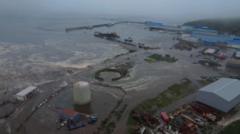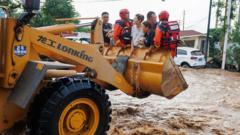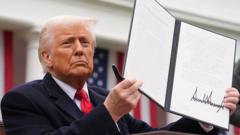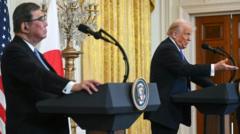In a significant display of naval strength, the Chinese Navy has sent two of its aircraft carriers into the Pacific Ocean for the first time, signaling its growing military presence and capabilities in the region.
China's Navy Makes Historic Move With Two Aircraft Carriers in the Pacific

China's Navy Makes Historic Move With Two Aircraft Carriers in the Pacific
China demonstrates military expansion as it sends dual aircraft carriers far beyond its coastline for joint exercises.
In a remarkable assertion of military capabilities, the Chinese Navy has deployed both the Liaoning and Shandong aircraft carriers into the Pacific Ocean for joint exercises, marking the first time these warships have ventured beyond Japan’s territories. Japanese Defense Minister Gen Nakatani reported on Monday that these carriers were observed conducting flight operations, including launching and recovering jet aircraft, in waters east of Iwo Jima, roughly 750 miles south of Tokyo.
This coordinated exercise began on Saturday and illustrates a crucial development in China's naval strategy, featuring a collaboration between its active-duty aircraft carriers and their accompanying support vessels in areas outside the First Island Chain—an area that has traditionally served as a defensive barrier for Japan against potential aggressions. The drills underscore China's advancing naval capabilities and intent to challenge U.S. influence in the western Pacific, especially in light of its claims over Taiwan, which is regarded by Beijing as its territory.
China has been enhancing its naval fleet, adding aircraft carriers to extend its reach further into the Pacific. In addition to the current Liaoning and Shandong, a third carrier, named Fujian, is in the midst of sea trials with a fourth under construction. In contrast to the U.S., which operates 11 large nuclear-powered carriers, the Chinese ships are still smaller and support fewer aircraft.
This recent deployment adds pressure on Japan, prompting it to develop its own capabilities by constructing its inaugural small aircraft carriers since World War II, designed to operate U.S.-made F-35B stealth fighters.
With this bold maneuver, China sends a clear message regarding its expanding influence and preparedness to face not only Japan but also to counter any U.S. maritime presence in the area should a crisis arise.
Hisako Ueno contributed to this report from Tokyo. Martin Fackler serves as the acting Tokyo bureau chief for The Times.
This coordinated exercise began on Saturday and illustrates a crucial development in China's naval strategy, featuring a collaboration between its active-duty aircraft carriers and their accompanying support vessels in areas outside the First Island Chain—an area that has traditionally served as a defensive barrier for Japan against potential aggressions. The drills underscore China's advancing naval capabilities and intent to challenge U.S. influence in the western Pacific, especially in light of its claims over Taiwan, which is regarded by Beijing as its territory.
China has been enhancing its naval fleet, adding aircraft carriers to extend its reach further into the Pacific. In addition to the current Liaoning and Shandong, a third carrier, named Fujian, is in the midst of sea trials with a fourth under construction. In contrast to the U.S., which operates 11 large nuclear-powered carriers, the Chinese ships are still smaller and support fewer aircraft.
This recent deployment adds pressure on Japan, prompting it to develop its own capabilities by constructing its inaugural small aircraft carriers since World War II, designed to operate U.S.-made F-35B stealth fighters.
With this bold maneuver, China sends a clear message regarding its expanding influence and preparedness to face not only Japan but also to counter any U.S. maritime presence in the area should a crisis arise.
Hisako Ueno contributed to this report from Tokyo. Martin Fackler serves as the acting Tokyo bureau chief for The Times.



















